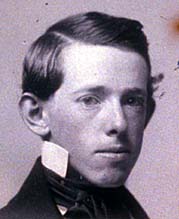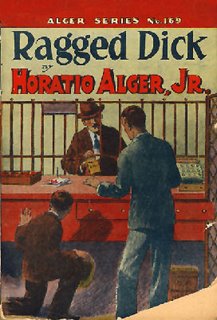
Portsmouth has a beautiful expensive new bridge, but the celebrating is over, and now it’s time to come to terms with reality and face the costs of that project, and not just in terms of dollars. On October 15th, the Community Common published a pathetic Sunday supplement called “Bridging the Past to the Future.” Contrary to the claim of the Common’s headline, the U.S. Grant Bridge is not a link to Portsmouth’s future, only to its past. The Grant Bridge is a 38 million dollar pork project, which cost millions more than it was projected to cost and experienced so many delays that it ended up taking longer to construct than the Golden Gate Bridge. The C.J. Mahan Company – which has been in trouble with the EPA, with its sub-contractors, with its endangered workers, and with the widow of one of its original partners – should not do any bragging about the Grant Bridge, for the sad irony is Mahan appears to be better at making excuses than building bridges.
Death of a Salesman
I heard somebody recently express disappointment that the bridge did not have a walkway for pedestrians, but there are advantages to excluding pedestrians. No homeless soul or depressed drug-addicted prostitute or destitute gambler (should the casinos come) are going to be able to walk out on the bridge and jump off, adding to Portsmouth’s “image problem.” People have been persistently jumping off the Golden Gate Bridge from the time it was built, but San Francisco is large enough and has enough going for it that millions of tourists have left their hearts there without thinking about Golden Gate suicides. But picture some clinically depressed traveling salesman calling up for reservations at Portsmouth’s downtown Ramada Inn, dubbed by one critical traveler the “Queen of the Rust Belt,” and asking, “Are you within jumping – I mean walking– distance of the Grant Bridge?” It would be bad for business, and there is little enough of that as it is. Instead of claiming to be “The Gateway to Southern Hospitality,” Portsmouth,with a walkway on the bridge, might have become known as “The Jumping off Spot for World Weary Travelers.”
Speaking of death, those who work with and for Mahan run financial and personal risks, including death itself. The bridge Mahan built across the Big Sandy River, the Perry and Gentry Memorial Bridge, is named after two workers who lost their lives building it. The barge that sank and the crane that went with it on the Grant project slowed things down, but fortunately no lives were lost. While the Grant Bridge was falling further and further behind schedule, partly as a result of serious design faults, Mahan was being sued by the wife of his original partner, who died unexpectedly. The widow claimed Mahan had cheated her out of her fair share of the company while awarding himself a super-sized salary and expense account. Court records show his annual salary in the mid-90s was $580,000 and his draw account alone was $355,000. In reviewing the judgment on the widow’s case, the courts decided that “there is competent, credible evidence to support the jury’s finding that Mahan received excessive compensation for the years 1996 and 1997.” If that’s what he was paying himself ten years ago, what must he be taking home now? The $900,000 in bonuses he has allegedly been awarded by Ohio Department of Transportation to get him to finally finish the Grant Bridge have understandably outraged taxpayers. Since when are huge bonuses awarded for being two years behind schedule? Instead of giving bonuses, the ODOT could have done what others who have grievances against him have done: sue him.
Considering what Ohio taxpayers will get for their money, the Grant Bridge is pork not just because of Mahan’s poor performance but because the 38 million dollars of public dollars that have been expended on it could have been better spent. If it is not as questionable as Alaska’s infamous “Bridge to Nowhere,” the Grant Bridge is a luxury, not a necessity. What justification was there in the first place for building the new Grant Bridge when the Carl D. Perkins bridge is about a mile down the road and has served as Portsmouth’s link to Kentucky in the five years that the Grant Bridge has been under construction? Trucks have used the Perkins Bridge since it was built in 1980 to avoid downtown Portsmouth, and during the five years (2001-2006) Portsmouth was without the Grant Bridge, motorists driving on Route 23 could use the Perkins bridge as a detour. For those motorists who had no reason to stop in Portsmouth, using the Perkins Bridge was no inconvenience. They drove a few more miles than if they had driven through Portsmouth, but they lost little time since they did not have to deal with all those traffic lights on Chillicothe Street. (Chillicothe St. is that quarter mile stretch of Rte. 23 that runs through downtown Portsmouth and has seven traffic lights.)

Map showing one mile distance between Perkins and Grant Bridges.
If the 38 million was not spent to save motorists a couple of minutes and a couple of miles driving on Rte. 23, then who or what was it spent for? The answer is the 38 million was spent to help revive Portsmouth’s depressed downtown district. That’s in addition to the millions that had already been spent for that purpose. The unfortunate truth is downtown Portsmouth died about a quarter of a century ago, and misguided politicians and Portsmouth con artists posing as community leaders have been claiming to have a plan to revive it ever since. The advocates of downtown Portsmouth are like those operators who were still milking the Missing in Action movement twenty years after the Vietnam War. The Marting scam would not have been possible without the Save the Downtown mentality, as if the downtown and the downtown alone was the key to the city’s salvation. When the industrial base of the Portsmouth area began disappearing a half century ago, many of the retail and commercial businesses in downtown Portsmouth that served and prospered from that industrial base, began to close shop. Even before the old Grant Bridge closed in 2001, downtown Portsmouth was in bad shape. Yes, the closing of the old Grant Bridge made a bad situation worse, but the spending of 38 million dollars to return to 2001 hardly seems a wise investment. “I would like to see all the buildings up and down Chillicothe Street occupied like they used to be when I came to Portsmouth in 1947,” an elderly Portsmouth resident told the Portsmouth Daily Times on the Bridge Day celebration. It ain’t going to happen, lady.
Insulting Consulting
According to the Oct. 18 Daily Times, we have yet another publicly funded study being done on how best to revive downtown Portsmouth. “Oh, my god!” a longtime resident of Portsmouth exclaimed on hearing about the study. “Not another one!” Having established that it is incapable of coming up with any solutions to the downtown Portsmouth problem on its own, the city government regularly insults the intelligence of the taxpayers by bringing in these so-called experts to do a study. The latest study is being conducted by a Cincinnati consulting firm, Edwards and Kelcey, whose fee is being paid in part by the city government, which is providing $23,000. More pork! If all the money spent on all the studies of downtown done in the last half century were put in a pot, the city would have enough to put a new roof on the leaking Municipal Building and have enough left over to provide Mayor Kalb with the luxury SUV he feels a man in his position should have. How can we take seriously any out-of-town consulting firm that knows so little about Portsmouth as to hold its initial public meeting in what is known unaffectionately locally as the UnWelcome Center. The UnWelcome Center is just another Portsmouth pork project that houses the offices of the Chamber of Commerce and the SOGP, Portsmouth's axis of evil, which has a stranglehold on the city. Not that the consulting firm had much choice. Folks at the the SOGP are probably behind this “study,” just as they were behind the Marting scam. And how can we take seriously a consulting firm that comes up with a gimmick of audience participation.
Those who attended the charade at the UnWelcome Center were encouraged to play the equivalent of pin-the-tail-on-the donkey, which would be more appropriate in a grade school than at a meeting of adults. The Edwards and Kelcey people put up a list of possible solutions to downtown Portsmouth on the wall, and those in the audience were invited to put red stickers on solutions they liked best. This is democracy at work, you see. But absent from the list of solutions was the most important one of all: Get Rid of the Goddamn SOGP! We ended up paying 38 million bucks for a bridge to revive downtown Portsmouth, and now we have to pay thousands of more public dollars to yet another consulting firm for yet another study on how to revive downtown Portsmouth. Why do we have so much faith in outside consultants anway? Do we assume they’re smarter than us because they don’t live and work in Portsmouth? What is an outside consultant after all if not somebody you pay to pick your pocket to tell you how much money you don't have?
Downtown Portsmouth is the Terri Schiavo of South Central Ohio. It has been on life-support for so long that not even Senator Frist would deny that it is in a persistent vegetative state. And when you consider the level of intelligence of the politicians in the Municipal Building, you could also say downtown Portsmouth is brain-dead. Any community planners with sense would see that any attempt to revive downtown Portsmouth as a retail and commercial center, as it was in the 1940s, is suffering from pernicious nostalgia. All the pork projects in the world, including a 38 million dollar bridge, or an 8 million scam project like the Marting building, is not going to bring back downtown Portsmouth. Not bring it back to anywhere near what it was anyway. A few years ago, Adelphia Cable (since absorbed by Time-Warner) moved its offices from downtown to the uptown Viaduct area, which is where Verizon later moved its downtown offices. And the Fifth/Third Bank is reportedly going to move out of its present downtown offices on Chillicothe St. If the few remaining corporate businesses are moving out of downtown, what do you think of our chances of getting others to move in? The overseers of these businesses are not brain dead. They know that downtown Portsmouth is a graveyard and buildings left behind, like the Marting building, are tombstones testifying to that fact. They know that building a 38 million dollar bridge to a graveyard doesn’t raise the dead. They know that downtowns are no longer the place to do business, at least not business as we know it. They know you don't make fire by rubbing two wet noodles together.
Not just downtown but all of Portsmouth is going to have to reinvent itself. Massive changes in industries, cities, and roads and transportation have taken place in the last half century. Portsmouth, along with the rest of America, is drastically different from what it was back then. American know-how was been replaced by American no-how, American enterprise by American porkbarreling. Those antique cars that were part of the Bridge Day parade could be accommodated in the old downtown Portsmouth. But vehicles are bigger and there are millions more of them. Half of downtown Portsmouth would have to be razed to accommodate the cars that a large shopping might attract, and I emphasize might. A shopping mall has been Portsmouth’s pipedream for a quarter of a century.
Gambling on the Future
 What a few wheeling and dealing developers, lawyers and politicians are counting on is casino gambling coming to Ohio and Portsmouth. As long as we are fed and continue to swallow the line that downtown Portsmouth can be revived like it was in the 1940s, that we can go forward to the past, the more likely is it that gambling is in our future. That’s the future they’re counting on. If you build casinos, they will come. Millions of dollars would be pumped into the local economy. But at what cost? The human hazardous waste gambling generates gets buried in the local community in the form of increased crime, corruption, drug abuse, divorce, and suicide rates. Already one of the most corrupt and crime-ridden cities in Ohio, Portsmouth would become Sodom-on-the-Ohio, utterly degraded by gambling dollars, which there will not be as many of as promoters promise but enough to create more serious social problems. Considering what a problem drugs and prostitution now are in Portsmouth, what will they be like with gambling money flowing like crack through the veins of the local economy? Gambling addicts, whose numbers are estimated by pro-gambling sources at 1% and by gambling opponents at 5%, will be a problem far beyond the 1 to 5%, because families, relatives, and employers are affected. It is called the ripple effect.
What a few wheeling and dealing developers, lawyers and politicians are counting on is casino gambling coming to Ohio and Portsmouth. As long as we are fed and continue to swallow the line that downtown Portsmouth can be revived like it was in the 1940s, that we can go forward to the past, the more likely is it that gambling is in our future. That’s the future they’re counting on. If you build casinos, they will come. Millions of dollars would be pumped into the local economy. But at what cost? The human hazardous waste gambling generates gets buried in the local community in the form of increased crime, corruption, drug abuse, divorce, and suicide rates. Already one of the most corrupt and crime-ridden cities in Ohio, Portsmouth would become Sodom-on-the-Ohio, utterly degraded by gambling dollars, which there will not be as many of as promoters promise but enough to create more serious social problems. Considering what a problem drugs and prostitution now are in Portsmouth, what will they be like with gambling money flowing like crack through the veins of the local economy? Gambling addicts, whose numbers are estimated by pro-gambling sources at 1% and by gambling opponents at 5%, will be a problem far beyond the 1 to 5%, because families, relatives, and employers are affected. It is called the ripple effect.
I grew up in Revere, Massachusetts, when it was known as “The Gambling Capital of New England,” so I am not basing what I say on some outside consultant’s study of the effects of gambling on Portsmouth, although we are going to get those studies, rest assured, studies probably paid for by gambling interests, studies that will say yes, there may be problems, but the overall effects of gambling are positive. The toxic effects of gambling are not limited to the casinos and the gamblers. Gambling is like mercury poisoning and PCB’s. Gambling contaminates whole communities – the political, social, and spiritual environment. The American dream of succeeding through hard work and honesty is replaced by the dream of instantly striking it rich. Life becomes a lottery. People dream about lucky numbers or combinations to play. If gambling comes, our current mayor will no longer have to drive across the river to gamble in the economy model city car he’s ashamed of. He can do his gambling in Portsmouth.
The indirect influence of gambling has been observable in Portsmouth for the last fifteen years. The deliberate neglect of the Municipal Building and the calls to tear it down are indirectly related to gambling. A developer has wanted that land for gambling-related purposes for a number of years. The longer we fall for the “forward to the past” line, the more likely we are going to wind up tearing down the Municipal Building and replacing it with a casino. Then adults will really be playing games, and it won’t be the pin-the-tail-on-the-donkey variety.
Bridge to the Future
 One thing that we might do is try to change Portsmouth politically, and see if political changes might help the economy. Lee Scott believes getting rid of the city charter might work wonders. I think what needs improving is the quality of the people who gravitate toward city government. It is too much to expect that the best and the brightest would want to get involved in city government, but do we have to settle for the worst and the dumbest, who become pawns in the hands of the richest and the slickest? Shawnee State University could be one institution to help raise the intellectual and ethical level of local government. Employees at the university and the students and faculty in particular have to care about and get involved more with Portsmouth politically.
One thing that we might do is try to change Portsmouth politically, and see if political changes might help the economy. Lee Scott believes getting rid of the city charter might work wonders. I think what needs improving is the quality of the people who gravitate toward city government. It is too much to expect that the best and the brightest would want to get involved in city government, but do we have to settle for the worst and the dumbest, who become pawns in the hands of the richest and the slickest? Shawnee State University could be one institution to help raise the intellectual and ethical level of local government. Employees at the university and the students and faculty in particular have to care about and get involved more with Portsmouth politically.
Little did the richest and slickest realize when they lobbied for a university what the consequences would be, because along with those millions of pork dollars that were pumped into the community came also students and faculty, who are not as easy to bamboozle as the general public. The Shawnee Sentinel was the creation of Shawnee State students, and since the paper first appeared back in the mid-1990s, news reporting in Portsmouth has not been the same. The appalling level of incompetence and dishonesty in local politics has been the main focus of the Shawnee Sentinel, but that newspaper arose in spite of harassment from the administration and from university lawyer, Stephen P. Donohue in particular.
The sick condition of Portsmouth’s economy and the corruption in government is a scandal that the university, a public institution, is ethically obligated to do something about. It should not be left to outside consultants who have no roots or stake in the city. In Athens, faculty members from Ohio University have actually served on the city council. Imagine having somebody connected with the university be mayor of Portsmouth instead of having men who never amounted to anything, like the present and former mayor? There should be some interdisciplinary program or institute established at SSU that directly relates to the political and economic affairs of Portsmouth. But the university is not likely to make much of a difference in the quality of life in Portsmouth without major changes first taking place there, which is unlikely since it is now controlled, like most things in town, by the SOGP, acting through the Board of Trustees. As long as trustees like George L. Davis III, George Clayton and the current trustee chair Kay Reynolds are in control of the university, and as long as Stephen P. Donohue is the Vice President of Everything and de facto SSU president, no constructive changes are likely to take place at SSU. However, with a former dedicated instructor at SSU in the governor’s office, perhaps something can be done about SSU, if only through the trustees he will have the opportunity to appoint.
SSU developed a terrible reputation over the last twenty years, when it was treated locally as another publicly funded pork project, another public feeding trough. The number of land scams and housing shenanigans that took place as the university expanded should be the study of a dissertation someday. We saw what happened to the one president of SSU, James P. Chapman, who was not a tool of the SOGP and who began to make a difference. People with a little more education, vision, and ethics, who are not lapdogs for local multimillionaires, could help build our bridge to the future. And is it too much to hope that that education bridge will not continue to be a pork project, costing hundreds of millions of dollars without taking the city anywhere? Is it too much to hope that someday somebody who is not the equivalent of C.J. Mahan will be in charge of building our bridge to the future, and that somebody other than a consulting firm of Edwards and Kelcey’s ilk will be offering us advice on how to proceed instead of inviting us to pin-the-tail-on-the-donkey, as if we were all, like those politicians in the Municipal Building, jackasses?
Dramatic political changes may take place after November 7 at both the state and national levels. Kevin Tillman, brother of former pro football player Pat Tillman, has published an extraordinary indictment of American politicians and policies, titled “After Pat’s Birthday.” “Somehow,” Kevin Tillman wrote, “the same incompetent, narcissistic, virtueless, vacuous, malicious criminals are still in charge of this country.” But is it too much to hope that on November 7 some important political changes might begin to take place not only at the national and state but at the local level as well? The same old virtueless, vacuous, malicious crooks are still in control of Portsmouth, but could their days be numbered?
 What a few wheeling and dealing developers, lawyers and politicians are counting on is casino gambling coming to
What a few wheeling and dealing developers, lawyers and politicians are counting on is casino gambling coming to  One thing that we might do is try to change
One thing that we might do is try to change 





